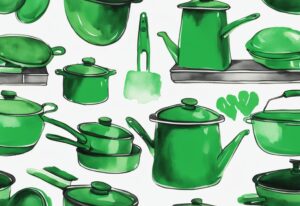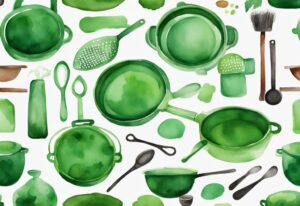Top Quality Oven Safe Silicone Molds for Your Baking Needs
Can you imagine a kitchen without those baking disasters of stuck, burned, or unevenly cooked treats? “Hello, dear reader, it’s Olivia Green again. Have you been wondering about those shiny, flexible oven safe silicone molds that are gaining popularity in kitchens globally? Are you on the fence about their safety and their impact on your health and our environment? Then, this comprehensive guide was written just for you.
Exciting, right? In this guide, you’ll discover the multitude of benefits these gamechangers bring to your kitchen, from their non-stick nature to their remarkable heat distribution. Plus, you’ll learn exactly why these molds are the unsung heroes for both baking newbies and seasoned chefs alike.
Join me, as we explore baking’s bright future with silicone molds, revolutionizing the way we cook and craft our favorite treats. With oven-safe silicone molds, a healthier, hassle-free, and eco-friendly culinary adventure awaits you. So, are you ready? Let’s dive in!
What Makes Silicone Molds Oven Safe?
Silicone molds have become a must-have in my kitchen, offering incredible safety and versatility. These oven safe silicone molds are perfect replacements for traditional bakeware thanks to their ability to withstand high baking temperatures.
These molds typically endure temperatures from 450°F to 500°F (232°C to 260°C). I’ve even come across high-quality ones that can handle temperatures from as low as -40°F to as high as 465°F. This durability means they won’t warp or degrade under extreme heat, making them ideal for both baking and freezing.
What I appreciate most about oven safe silicone molds is their construction from food-safe silicone. Unlike some plastics, these molds don’t release harmful chemicals like BPA or lead when heated. This makes them a healthier choice for those of us who want to avoid toxins in our kitchens, and you can explore more about safe cookware options in this [guide to the best non-toxic cookware](https://www.foodandwine.com/lifestyle/kitchen/best-non-toxic-cookware).
Moreover, oven safe silicone molds are crafted from high-quality materials that ensure even heat distribution. Many premium options include internal knitted fiberglass structures, enhancing both their durability and heat transfer. This thoughtful design means your cakes, muffins, and other baked goods will cook evenly, without burnt edges or undercooked centers.
Ultimately, the careful engineering behind these oven safe silicone molds makes them a standout choice for both home and professional bakers. Their high-temperature tolerance, food-safe composition, and advanced construction techniques offer a baking experience that’s both safe and effective.
The Advantages of Using Oven Safe Silicone Molds
Food Safety: Non-Toxic and Safe
Oven safe silicone molds are a top choice for anyone passionate about food safety. Made from hypoallergenic silicone, these molds are completely free from harmful chemicals like phthalates and BPA. This ensures that no toxic substances leach into your food when they are subjected to high temperatures in the oven. Their non-toxic nature makes them a reliable option for everyday baking, giving you peace of mind that what you’re serving is safe for consumption.
The Non-Stick Benefits of Silicone Molds
One of the standout features of oven safe silicone molds is their natural non-stick property. This eliminates the need for excessive greasing, which not only saves time but also promotes healthier baking by reducing the use of additional fats. Baked goods release effortlessly from these molds, minimizing the risk of damage and preserving the integrity of your creations. In addition, silicone molds excel at preventing hot spots, ensuring your goods bake evenly and preventing those dreaded burnt edges that can ruin your culinary masterpieces.
Ease of Demolding Thanks to the Flexibility
The flexibility of oven safe silicone molds makes demolding a breeze. Unlike rigid metal or glass bakeware, silicone molds can be twisted and manipulated without warping or losing their shape. This flexibility is particularly advantageous for intricate and detailed designs, allowing you to demold even the most delicate creations with ease. Say goodbye to the frustration of cakes sticking to the pan or breaking apart during removal. With silicone molds, a gentle peel is all it takes to release your perfectly shaped baked goods.
The Durability and Reusability of Silicone Molds
Durability is another key benefit of oven safe silicone molds. Constructed to withstand high temperatures and frequent use, these molds maintain their shape and performance over time. They are reusable, offering excellent value for money as you can use them repeatedly without compromising their quality. Additionally, silicone molds are resistant to rust and damage, unlike traditional metal bakeware, making them a long-lasting addition to your kitchen arsenal. Whether you’re a novice baker or a seasoned pro, investing in silicone molds will enhance your baking experience and yield professional-quality results every time.
How to Use Your Oven Safe Silicone Molds to Their Full Potential
Oven safe silicone molds are game-changers in the kitchen and beyond, offering endless possibilities for baking, crafting, and cooking. Let’s delve into how you can make the most out of these versatile tools with practical tips and experiences.
Baking Perfect Cakes, Muffins, and Cupcakes
When it comes to baking, oven safe silicone molds are akin to a baker’s secret weapon.
They ensure even heat distribution, which is crucial for avoiding those dreaded overcooked edges and undercooked centers. With an array of shapes and sizes, these molds cater to your baking needs, whether you’re whipping up mini muffins or creating intricate cake designs.

One feature that stands out is their flexibility. It makes demolding a breeze, preserving the integrity of your baked goods and making presentation a cinch. I’ve found that these molds often lead to consistent, picture-perfect results.
Creating Flawless Candy and Chocolate
For candy makers and chocolate enthusiasts, specialized oven safe silicone molds are a dream. Their natural non-stick properties ensure your treats release effortlessly, retaining their beautiful shapes every time.
Silicone’s ability to handle a broad range of temperatures is a huge advantage. Whether you’re melting chocolate or setting candies, these molds transition seamlessly between hot and cold processes. This allows for professional-quality sweet treats that look as good as they taste.
Silicone Molds for Crafting: Resin, Candles, and Soap
Beyond the kitchen, oven safe silicone molds are indispensable in crafting projects. Their flexibility is particularly beneficial when working with delicate and intricate pieces. Whether you’re casting resin, making soap, or crafting candles, the ease of demolding is invaluable.
Some molds even come with small posts, which are perfect for creating pre-made holes in items like candles. Their durability and adaptability ensure that each project meets high standards of quality, delighting craft enthusiasts with every use.
Innovative Cooking Uses: Grilling and Microwaving with Silicone Molds
Oven safe silicone molds go far beyond baking. They can revolutionize your grilling and microwaving experiences. Use them to create uniform shapes of grilled foods, adding both creativity and precision to your meals.
They are also microwave-safe, which is perfect for quick cooking and reheating. Ideal for single-serving meals and snacks, these molds bring an element of ease and efficiency to your culinary adventures. Their versatility encourages you to explore new cooking methods, with satisfying results.
Integrating oven safe silicone molds into your kitchen and crafting repertoire not only elevates your creations but also simplifies the process, making every project more enjoyable and successful.
How Temperature Affects Your Oven Safe Silicone Molds
Leveraging High Temperature Resistance for Better Results
Oven safe silicone molds are ingeniously designed to handle high temperatures, making them perfect for a myriad of cooking and baking adventures. These molds can endure temperatures ranging from 450°F to 500°F (232°C to 260°C) without any damage or warping.
This remarkable heat resistance ensures that you can confidently use them for recipes requiring intense heat, whether you’re baking cookies or creating artisanal bread. One of the most comforting aspects is that, unlike some other materials, silicone molds won’t release harmful chemicals or odors when exposed to heat. This keeps your food pure and safe, a crucial factor when striving for non-toxic living.
Ensuring Even Heat Distribution for Perfect Baking
Oven safe silicone molds offer another fantastic advantage: even heat distribution. This characteristic is essential for achieving uniformly baked goods. Uneven heat can ruin your culinary creations, causing burnt edges or undercooked centers.
Silicone molds excel at spreading heat uniformly, ensuring that every part of your food cooks evenly. To get the most out of this feature, consider using a baking and cooling tray. This not only adds stability but also helps maintain consistent heat across the entire baking surface. The result? Perfectly cooked cakes, muffins, and intricate pastries, free from burnt edges or soggy centers. This practical tip can elevate your baking game, turning everyday treats into flawlessly baked masterpieces.
Must-Know Safety Tips for Using Oven Safe Silicone Molds
When working with oven safe silicone molds, understanding how to handle, clean, and maintain them is key. These guidelines will guide you through every aspect to ensure your safety and prolong the life of your silicone molds.
Guidelines for Proper Handling and Use
When using oven safe silicone molds, it’s crucial to follow guidelines for proper handling to ensure safety and longevity. Firstly, avoid placing silicone molds directly on an open flame, as this can cause them to melt. For added stability, always place your silicone molds on a baking sheet. This not only makes them easier to handle but also ensures an even distribution of heat, improving your baking results.
Additionally, while removing baked goods, avoid using sharp objects, as this can damage the silicone material. Employing these guidelines will help maintain the quality and lifespan of your silicone molds.
Cleaning and Maintenance Best Practices
Proper cleaning and maintenance are essential for keeping your oven safe silicone molds in optimal condition. Use a soft sponge and mild dish soap for washing, as harsh cleaning agents can deteriorate the silicone over time. Although silicone molds are occasionally dishwasher safe, hand washing is recommended to extend their lifespan.

Regular cleaning is vital to prevent the buildup of oils and residues that can lead to odors and discoloration. By adhering to these cleaning practices, you can ensure that your silicone molds remain safe and effective for repeated use.
Tools That Can Damage Your Silicone Molds and How to Avoid Them
To maintain the integrity of your oven safe silicone molds, it’s essential to avoid using certain types of tools that can cause damage. Metal utensils, sharp knives, and abrasive cleaning tools can easily nick and tear the silicone. Instead, opt for silicon, wooden, or plastic utensils when working with your molds.
Proper storage also plays a critical role in preserving their shape and functionality. Store your molds in a way that avoids dents and strains, thus keeping them in perfect condition for your baking and crafting needs.
Optimal Use of Oven Safe Silicone Molds: Pro Tips
When it comes to oven safe silicone molds, understanding how to prepare, bake, and cool effectively can be a game-changer. The following insights will help you achieve impeccable results with every bake.
Preparing Your Molds for Best Results
When it comes to preparing your oven safe silicone molds, a little initial effort can make all the difference. In my experience, lightly greasing the molds for the first few uses—even though they are naturally non-stick—ensures a flawless release of your baked goods. It’s a tip I learned the hard way after a few sticky mishaps!
Ensuring your molds are thoroughly dry before use is equally important. I’ve noticed that any residual moisture can create steam during baking, disrupting even heat distribution. This seemingly small step has a big impact on the quality of your baked products. Trust me; starting with dry molds sets the stage for consistent, delicious outcomes.
The Role of Baking and Cooling Trays
Using baking and cooling trays in conjunction with your silicone molds can noticeably improve your baking results. I always place my oven safe silicone molds on a sturdy baking sheet. This added stability makes handling easier and helps maintain the mold’s shape during baking.
Once your baking is complete, transferring the molds to a cooling tray is crucial. I’ve come to appreciate how even cooling plays a significant role in the final texture and ease of demolding. This step allows the baked goods to firm up properly, making them not only look good but also easier to release from the mold without compromising their shape.
Cooling Food Properly Before Removal
Patience truly is a virtue when it comes to using oven safe silicone molds. After baking, I’ve found it beneficial to let the goods cool slightly in the mold. This brief cooling period allows the food to firm up, minimizing the risk of breaking or sticking during removal.
When you’re ready to demold, gently peel the silicone mold away from the edges rather than pushing the baked good out. This delicate approach has saved many of my creations from disaster, preserving their shape and making them look as delectable as they taste. Proper cooling combined with careful handling always ensures flawless results.
Cleaning and Maintaining Your Oven Safe Silicone Molds
Ensuring your oven safe silicone molds remain in top condition is essential for both longevity and performance. Here we’ll explore the best methods for cleaning and maintaining these versatile kitchen tools.
Hand Washing vs. Dishwashing: Which is Better?
For maintaining the longevity of your oven safe silicone molds, hand washing is highly recommended. Use mild dish soap and a soft sponge to clean the molds gently, ensuring all food residues are removed without damaging the silicone.
Although oven safe silicone molds are generally dishwasher-safe, it’s wise to avoid placing them with sharp objects that might nick or cut the silicone. This practical step can safeguard the molds from unintended damage, significantly extending their useful life.
How to Remove Stubborn Stains and Odors
If stubborn stains persist on your oven safe silicone molds, creating a paste using baking soda and water can be an effective solution. Apply the paste to the stained areas, allow it to sit for a few minutes, and then scrub gently with a soft sponge.

For neutralizing lingering odors, soak the molds in a mixture of vinegar and water; the acidic nature of vinegar helps to eliminate strong smells effectively. It’s crucial to avoid using harsh chemicals, as these can degrade the silicone material, compromising its non-toxic and safe properties.
Silicone Molds vs. Traditional Bakeware: A Comparative Analysis
Comparing Silicone and Metal Molds
Silicone molds, especially the oven safe silicone molds, offer numerous advantages over traditional metal molds. With silicone molds, there’s no need for greasing, which not only saves time but also ensures your baked goods release effortlessly, preserving those intricate details and shapes that bring so much joy.
Metal molds, particularly those lined with Teflon, often fall prey to sticky residues and rust over time. In contrast, silicone molds are inherently resistant to rust and sticky build-ups, making them a more durable and low-maintenance option. Plus, their flexibility means you can easily store them without worrying about damage.
One of the biggest perks of silicone molds is how quickly they cool down compared to metal molds. This is more than a convenience—it’s a safety feature that reduces the risk of burns when you’re handling your freshly baked creations. Imagine the ease of bending and twisting the mold without any fear of it breaking, something metal molds simply can’t offer.
Silicone vs. Glass Bakeware: Advantages and Disadvantages
When considering oven safe silicone molds versus glass bakeware, several points come into focus. Silicone’s unmatched flexibility and durability make it perfect for a wide array of baking tasks. The ease with which you can remove baked goods without them cracking or breaking is a game-changer, especially compared to the rigid nature of glass bakeware.
However, glass has its own merits. It holds onto heat longer, which can be beneficial for recipes that demand consistent heat. Yet, this virtue can also be a downside, as the prolonged cooling time increases the risk of burns.
The weight and fragility of glass bakeware are other important factors. Glass is typically heavier and quite fragile, susceptible to breaking if dropped or exposed to sudden temperature changes. Conversely, silicone molds are lightweight and remarkably sturdy, making them a safer and more convenient choice for everyday baking.
By opting for oven safe silicone molds, you’re embracing flexibility, safety, and durability. These qualities make silicone molds a practical choice for both novice and seasoned bakers, blending ease of use with reliable performance.
Frequently Asked Questions on Oven Safe Silicone Molds
Are Silicone Molds Better for Baking Than Metal Pans?
Silicone molds bring several non-stick benefits, making cleanup a breeze and reducing the need for greasing. Plus, their flexibility and versatility in design options accommodate a variety of shapes and configurations. While metal pans may offer superior heat conduction for certain recipes, they require meticulous greasing and can be prone to sticking. From my own experience, silicone molds have revolutionized my baking routine, offering convenience without compromising results.
Can I Use Silicone Molds in the Freezer?
Yes, oven safe silicone molds can also seamlessly transition between high and low temperatures. They excel in the freezer, making them perfect for crafting frozen desserts and ice molds. I love how the flexibility of silicone ensures easy demolding, even when frozen solid. This quality has been a game changer in my kitchen, allowing me to experiment with a variety of cold recipes.
How to Ensure Even Baking with Silicone Molds?
Ensuring even baking using silicone molds starts with placing them on a baking sheet. This step helps distribute heat evenly. I always preheat my oven thoroughly before inserting the molds, and midway through baking, I rotate the baking tray. These small steps make a big difference in achieving consistent outcomes, something I learned through trial and error.
Are All Silicone Molds Safe for Food Use?
It’s crucial to only use food-grade silicone molds for baking and cooking. Make sure the molds are explicitly labeled as food-safe. This specification guarantees they don’t contain harmful chemicals and are safe for food preparation. I can’t stress enough how essential this is for maintaining a non-toxic and health-conscious kitchen.
How to Prevent Silicone Molds from Retaining Odors?
To prevent your silicone molds from retaining odors, clean them thoroughly after each use. I usually resort to a mixture of vinegar and baking soda to tackle stubborn smells. After washing, store the molds in a dry, cool place to minimize odor retention. With these practices, my silicone molds have stayed fresh and odor-free over time.
Hi, I’m Olivia Green, the voice behind nontoxicways.com. I’m passionate about helping you make the shift to a healthier, non-toxic lifestyle without feeling overwhelmed. I love sharing my personal journey, from small changes to big transformations, along with practical tips that make it all feel doable. My goal is to inspire and guide you toward a lifestyle that benefits both your well-being and the planet. Let’s take this journey together, one simple step at a time!














Post Comment